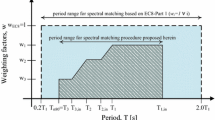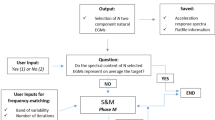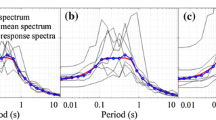Abstract
This paper makes use of different ground motion selection and scaling methods for the identification of predominantly first-mode engineering demand parameters (EDPs) of bridges under earthquake excitation. Two groups of ground motions are selected for this purpose. The first group, expected to result primarily in the first-mode response, is selected using the conditional mean spectrum (CMS) method. The second group, which serves as the reference for comparison, is selected to match a chosen scenario response spectrum. Since the shape of the chosen scenario spectrum allows higher mode response, the ground motions in this second group are considered as the ground motions with higher mode effects. Both groups of ground motions are selected using a method that seeks to match the mean and variance of the target spectrum. Comparison of the nonlinear time-history analysis responses from the two groups for three chosen ground motion scenarios indicates that higher mode effects are more pronounced on column displacements and deck accelerations than the column shear forces.
Access provided by Autonomous University of Puebla. Download chapter PDF
Similar content being viewed by others
Keywords
These keywords were added by machine and not by the authors. This process is experimental and the keywords may be updated as the learning algorithm improves.
1 Introduction
The nonlinear structural response of bridge systems, similar to most complex structures, is intricate that it is often highly sensitive to the selection and modification of the input ground motions. This paper makes use of different ground motion selection and scaling methods for the identification of predominantly first-mode engineering demand parameters (EDPs) of bridges under earthquake excitation.
Two groups of ground motions are selected for this purpose. The first group, expected to result primarily in the first-mode response, is selected using the conditional mean spectrum, namely the CMS method. The second group, which serves as the reference for comparison, is selected to match a chosen scenario response spectrum. Since the shape of the chosen scenario spectrum allows higher mode response, the ground motions in this second group are considered as the ground motions with higher mode effects. Both groups of ground motions are selected using a method that seeks to match the mean and variance of the target spectrum. Nonlinear time-history analyses were conducted for selected highway bridges modeled in OpenSees [1] using the two groups of ground motions. Comparison of the nonlinear time-history analysis responses from the two groups for three chosen ground motion scenarios indicates that higher mode effects are more pronounced on column displacements and deck accelerations than the column shear forces. Therefore, the column base shear is likely a first-mode-dominant EDP.
2 Bridge Structures and Analytical Models
Three highway bridge structures, reflecting common practice in California, are used in this study. These bridges are: (1) Jack Tone Road Overcrossing (Bridge A), a bridge with two spans supported on a single-column bent, (2) La Veta Avenue Overcrossing (Bridge B), a bridge with two spans and a two-column bent, and (3) Jack Tone Road Overhead (Bridge C), a bridge with three spans and two three-column bridge bents. Extensive simulations were conducted on these bridges [2] using OpenSees [1], on which the modeling assumptions adopted herein are based. OpenSees [1] has a sufficient element and material response library and empowers scripted execution of repetitive nonlinear time-history analyses (NLTA) through which the model parameters and input ground motions can be systematically varied. The bridge models used in the simulations are depicted in Figs. 1 and 2. Seat-type abutments, shear keys, expansion joints, column-bents, and the superstructure are included in the model. For a detailed explanation of the employed modeling assumptions, refer to the descriptions in [3].
Modeling of bridge B [2]
Modeling of the analyzed bridges [3]. a Bridge A, b bridge B, c bridge C
Two approaches are considered for abutment modeling: detailed and simplified. In both approaches, the longitudinal responses of the backfill and the expansion joint, the transverse responses of the shear keys, and the vertical responses of the bearing pads and the stemwall are all explicitly considered. In the detailed modeling approach (Fig. 3a), five nonlinear springs, connected in series to gap elements, are used to model the passive backfill response and the expansion joint. The strength and initial stiffness of the soil springs are determined according to Caltrans SDC [4]. The shear key response is modeled using a nonlinear spring with a tri-linear backbone curve. The vertical response of the bearing pads and the stemwall is modeled by two parallel springs that represent the stiffness of the bearing pads and the stemwall. In the simplified modeling approach, the number of nonlinear springs connected in series to the gap elements is reduced to two as shown in Fig. 3b, and the shear key response is modeled using an elastic-perfectly-plastic backbone curve.
Springs and gap elements used to model various components of the abutment [3]. a Detailed modeling, b simplified modeling
3 Ground Motion Selection
For each bridge, three earthquake scenarios are considered, namely those with 2, 10 and 50 % probabilities of exceedance (POE) in 50 years. The attenuation model by Campbell and Bozorgnia [5] is used to approximate these three hazard levels. Figure 4 shows Uniform Hazard Spectra (UHS) of the three hazard levels and their approximations for the site of Bridge B.
The CMS [6], which is a response spectrum associated with a target value of the spectral acceleration Sa at a single period, serves as the target spectrum for the first group of ground motions. In this study, this single period is the fundamental period of the considered bridge. The second group, which serves as the reference for comparison, is selected to match the spectrum predicted by the attenuation model of Campbell and Bozorgnia [5]. Figure 5a shows the response spectrum by the attenuation model from Campbell and Bozorgnia [5] that approximates the UHS at hazard level of 10 % POE in 50 years for Bridge B, i.e. the target spectrum for the second (reference) group. Also shown in Fig. 5a is the CMS [6] anchored at the fundamental period of Bridge B of 1.1 s, which is the target spectrum for the first group. As mentioned before, both groups of ground motions are selected using a method proposed by Jayaram et al. [7] that seeks to match the mean and variance of the target spectrum (Fig. 5b). With a target distribution, Monte Carlo simulation is used to probabilistically generate multiple realizations of response spectra, and then recorded ground motions whose response spectra individually match the simulated response spectra are selected. Furthermore, a greedy optimization is applied to improve the match between the target and the sample means and variances. This is performed by replacing one previously selected ground motion at a time with a record from the database that generates the best improvement in the match. For a detailed explanation of this method, refer to [7].
4 Simulation Results
As discussed above, there are two approaches for abutment modeling: detailed (Fig. 3a) and simplified (Fig. 3b). For each of the two abutment modeling of each of the three bridges, 40 ground motion records are selected for each of the three scenarios per each of the two ground motion groups, and NLTA are conducted with the selected ground motions, which yield a total of 2 × 40 × 3 × 2 = 480 simulations per bridge for the three considered bridge systems. The maximum column drift ratio, base shear, and deck total acceleration are selected as the EDPs.
Figures 6, 7 and 8 present the ratios of the median EDPs from the ground motions of the first group (CMS) to those from the ground motions of the second reference group. Because the first and second groups are the first-mode dominant and higher mode response reflecting ground motions, respectively, the smaller the ratio, the more the considered EDP is affected by the higher modes. It is observed that the ratio for the column base shear is close to 1.0 and almost invariant for both modeling cases and the three scenarios. On the other hand, the ratios for the column drift and deck acceleration are always less than 1.0 and reduce as the hazard level and the corresponding nonlinearity level increase. Accordingly, it is concluded that the higher mode effects are more pronounced on column displacements and deck accelerations than on column shear forces. Moreover, the effects of higher modes on the column drift and deck acceleration increase with increasing nonlinearity. However, the column base shear is likely to be a first-mode dominant EDP, independent of the hazard level.
For the 10 and 2 % POE in 50 years cases, the first mode dominancy of the column base shear can be explained by the fact that it is limited by the base shear capacity of the column (direct shear or the shear force limited by flexure). However this explanation is not valid for the 50 % POE in 50 years scenario, where the response is below the column base shear capacity, indicating that the column base shear is not affected from higher modes also in the linear range.
It is noted that the comparison is not recorded for Bridge C with detailed abutment modeling for the hazard level of 2 % POE in 50 years. This is due to the fact that 7 out of 40 ground motion records in the second group failed to converge, despite significant efforts to improve convergence [8].
The results in Figs. 6, 7 and 8 are supportive of the statement that the higher modes affect the response of bridges to a greater extent than that of buildings as indicated in [9]. Furthermore, examining the obtained results from a ground motion selection aspect, it can be stated that the CMS method underestimates the column drift ratio and the deck total acceleration with respect to the ground motions selected to match the UHS. In order to evaluate the accuracy of these methods, an estimate of the true response can be obtained using the concept of high-end prediction (HEP) [10, 11]. However, this investigation is beyond the scope of the presented study.
5 Summary and Conclusions
This study employed different ground motion selection and scaling methods to identify the predominantly first-mode engineering demand parameters (EDPs) of bridges under earthquake excitation. For this purpose, the median maximum responses of three selected EDPs, namely column drift ratio, the column base shear, and the deck total acceleration, from two groups of ground motions, were investigated. The responses from the first group, selected using the conditional mean spectrum, were expected to represent the first-mode-dominant response. The responses from the second group, with the spectrum shape allowing higher mode responses, were considered as responses including the higher mode effects. A method that seeks to match both the mean and variance of the target spectrum was utilized for selection of ground motions for the two groups. Comparison of the responses from 1440 nonlinear time-history analyses obtained from the two groups for three representative ground motion scenarios, i.e. 50, 10 and 2 % probability of exceedance in 50 years, on three bridge systems with two approaches to model their abutments, indicated the higher mode effects are more pronounced on column displacements and deck accelerations than on column shear forces, the effect of higher modes increases with increasing nonlinearity and the column base shear is a first-mode-dominant EDP, independent of the hazard level.
References
McKenna F, Fenves GL, Filippou FC, OpenSees, 2010
Kaviani P, Zareian F, Taciroglu E (2012) Seismic behavior of reinforced concrete bridges with skew-angled seat-type abutments. Eng Struct 45:137–150
Kaviani P (2011) Performance-based seismic assessment of skewed bridges. Ph.D. dissertation, University of California, Irvine
Caltrans SDC (2010) Caltrans seismic design criteria, version 1.6, California Department of Transportation, Sacramento
Campbell KW, Bozorgnia Y (2008) NGA ground motion model for the geometric mean horizontal component of PGA, PGV, PGD and 5 % damped linear elastic response spectra for periods ranging from 0.01 to 10 s. Earthq Spectra 24:139–171
Baker JW (2011) Conditional mean spectrum: tool for ground motion selection. ASCE J Struct Eng 137(3):322–331
Jayaram N, Lin T, Baker JW (2011) A computationally efficient ground-motion selection algorithm for matching a target response spectrum mean and variance. Earthq Spectra 27(3):797–815
Liang X, Günay S, Mosalam KM (2014) Integrators for nonlinear response history analyses: revisited. In: Proceedings of the Istanbul bridge conference, Istanbul, Turkey
Kappos AJ, Gkatzogias KI (2013) Gidaris IG extension of direct displacement-based displacement-based design methodology for bridges to account for higher mode effects. Earthq Eng Struct Dynam 42:581–602
Haselton CB, Baker JW, Bozorgnia Y, Goulet CA, Kalkan E, Luco N, Shantz TJ, Shome N, Stewart JP, Tothong P, Watson-Lamprey JA and Zareian F (2009) Evaluation of ground motion selection and modification methods: predicting median interstory drift response of buildings technical report 2009/01, Pacific Earthquake Engineering Research Center, University of California, Berkeley
Mobasher, B, Junca PP, Zareian F, Haselton CB (2013) Sensitivity of response of seat-type abutment bridges to ground motion selection and scaling methods. In: 10th international conference on urban earthquake engineering, Tokyo
Acknowledgments
This research was supported by Caltrans under Contract Number 65A0454 for the Project “Guidelines for Nonlinear Seismic Analysis of Ordinary Bridges: Version 2.0”. The authors thank Prof. F. Zareian, UC Irvine, for providing the OpenSees models.
Author information
Authors and Affiliations
Corresponding author
Editor information
Editors and Affiliations
Rights and permissions
Copyright information
© 2016 Springer International Publishing Switzerland
About this chapter
Cite this chapter
Liang, X., Günay, S., Mosalam, K.M. (2016). Seismic Response of Bridges Considering Different Ground Motion Selection Methods. In: Caner, A., Gülkan, P., Mahmoud, K. (eds) Developments in International Bridge Engineering. Springer Tracts on Transportation and Traffic, vol 9. Springer, Cham. https://doi.org/10.1007/978-3-319-19785-2_12
Download citation
DOI: https://doi.org/10.1007/978-3-319-19785-2_12
Published:
Publisher Name: Springer, Cham
Print ISBN: 978-3-319-19784-5
Online ISBN: 978-3-319-19785-2
eBook Packages: EngineeringEngineering (R0)












